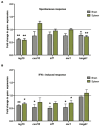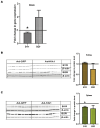Tissue Kallikrein-1 Suppresses Type I Interferon Responses and Reduces Depressive-Like Behavior in the MRL/lpr Lupus-Prone Mouse Model
- PMID: 39337564
- PMCID: PMC11432477
- DOI: 10.3390/ijms251810080
Tissue Kallikrein-1 Suppresses Type I Interferon Responses and Reduces Depressive-Like Behavior in the MRL/lpr Lupus-Prone Mouse Model
Abstract
Excessive production and response to Type I interferons (IFNs) is a hallmark of systemic lupus erythematosus (SLE). Neuropsychiatric lupus (NPSLE) is a common manifestation of human SLE, with major depression as the most common presentation. Clinical studies have demonstrated that IFNα can cause depressive symptoms. We have shown that the kallikrein-kinin system (KKS) [comprised of kallikreins (Klks) and bradykinins] and angiotensin-converting enzyme inhibitors suppressed Type I IFN responses in dendritic cells from lupus-prone mice and human peripheral blood mononuclear cells. Tissue Klk genes are decreased in patients with lupus, and giving exogenous Klk1 ameliorated kidney pathology in mice. We retro-orbitally administered mouse klk1 gene-carrying adenovirus in the Murphy Roths Large lymphoproliferative (MRL/lpr) lupus-prone mice at early disease onset and analyzed immune responses and depressive-like behavior. Klk1 improved depressive-like behavior, suppressed interferon-responsive genes and neuroinflammation, and reduced plasma IFNα levels and proinflammatory cytokines. Klk1 also reduced IFNAR1 and JAK1 protein expression, important upstream molecules in Type I IFN signaling. Klk1 reduced bradykinin B1 receptor expression, which is known to induce proinflammatory response. Together, these findings suggest that Klk1 may be a potential therapeutic candidate to control IFNα production/responses and other inflammatory responses in SLE and NPSLE.
Keywords: depression; kallikrein–kinin system; neuropsychiatric lupus; tissue kallikreins; type I interferons.
Conflict of interest statement
The authors declare no conflicts of interest.
Figures










References
-
- Morrison E., Carpentier S., Shaw E., Doucette S., Hanly J.G. Neuropsychiatric systemic lupus erythematosus: Association with global disease activity. Lupus. 2014;23:370–377. - PubMed
MeSH terms
Substances
Grants and funding
LinkOut - more resources
Full Text Sources
Medical
Research Materials
Miscellaneous

